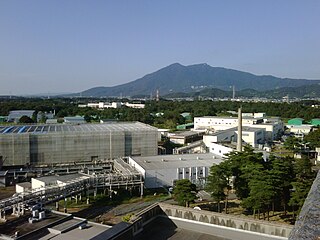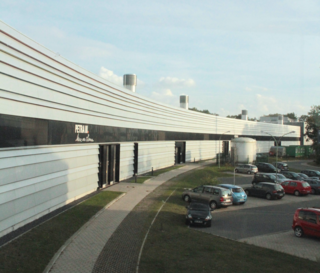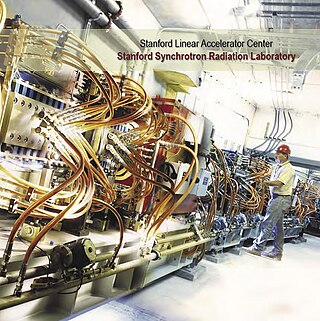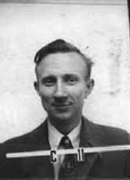
DESY, short for Deutsches Elektronen-Synchrotron, is a national research centre for fundamental science located in Hamburg and Zeuthen near Berlin in Germany. It operates particle accelerators used to investigate the structure, dynamics and function of matter, and conducts a broad spectrum of interdisciplinary scientific research in four main areas: particle and high energy physics; photon science; astroparticle physics; and the development, construction and operation of particle accelerators. Its name refers to its first project, an electron synchrotron. DESY is publicly financed by the Federal Republic of Germany and the Federal States of Hamburg and Brandenburg and is a member of the Helmholtz Association.

Brookhaven National Laboratory (BNL) is a United States Department of Energy national laboratory located in Upton, Long Island, and was formally established in 1947 at the site of Camp Upton, a former U.S. Army base and Japanese internment camp. Its name stems from its location within the Town of Brookhaven, approximately 60 miles east of New York City. It is managed by Stony Brook University and Battelle Memorial Institute.

SLAC National Accelerator Laboratory, originally named the Stanford Linear Accelerator Center, is a federally funded research and development center in Menlo Park, California, United States. Founded in 1962, the laboratory is now sponsored by the United States Department of Energy and administrated by Stanford University. It is the site of the Stanford Linear Accelerator, a 3.2 kilometer (2-mile) linear accelerator constructed in 1966 that could accelerate electrons to energies of 50 GeV.

A linear particle accelerator is a type of particle accelerator that accelerates charged subatomic particles or ions to a high speed by subjecting them to a series of oscillating electric potentials along a linear beamline. The principles for such machines were proposed by Gustav Ising in 1924, while the first machine that worked was constructed by Rolf Widerøe in 1928 at the RWTH Aachen University. Linacs have many applications: they generate X-rays and high energy electrons for medicinal purposes in radiation therapy, serve as particle injectors for higher-energy accelerators, and are used directly to achieve the highest kinetic energy for light particles for particle physics.
ISABELLE was a 200+200 GeV proton–proton colliding beam particle accelerator partially built by the United States government at Brookhaven National Laboratory in Upton, New York, before it was cancelled in July, 1983.

A synchrotron is a particular type of cyclic particle accelerator, descended from the cyclotron, in which the accelerating particle beam travels around a fixed closed-loop path. The magnetic field which bends the particle beam into its closed path increases with time during the accelerating process, being synchronized to the increasing kinetic energy of the particles. The synchrotron is one of the first accelerator concepts to enable the construction of large-scale facilities, since bending, beam focusing and acceleration can be separated into different components. The most powerful modern particle accelerators use versions of the synchrotron design. The largest synchrotron-type accelerator, also the largest particle accelerator in the world, is the 27-kilometre-circumference (17 mi) Large Hadron Collider (LHC) near Geneva, Switzerland, built in 2008 by the European Organization for Nuclear Research (CERN). It can accelerate beams of protons to an energy of 13 tera electronvolts (TeV or 1012 eV).

The High Energy Accelerator Research Organization, known as KEK, is a Japanese organization whose purpose is to operate the largest particle physics laboratory in Japan, situated in Tsukuba, Ibaraki prefecture. It was established in 1997. The term "KEK" is also used to refer to the laboratory itself, which employs approximately 695 employees. KEK's main function is to provide the particle accelerators and other infrastructure needed for high-energy physics, material science, structural biology, radiation science, computing science, nuclear transmutation and so on. Numerous experiments have been constructed at KEK by the internal and international collaborations that have made use of them. Makoto Kobayashi, emeritus professor at KEK, is known globally for his work on CP-violation, and was awarded the 2008 Nobel Prize in Physics.

The Positron–Electron Tandem Ring Accelerator (PETRA) is one of the particle accelerators at the German national laboratory DESY in Hamburg, Germany. At the time of its construction, it was the biggest storage ring of its kind and still is DESY's second largest synchrotron after HERA. PETRA's original purpose was research in elementary particle physics. From 1978 to 1986, it was used to study electron–positron collisions with the four experiments JADE, MARK-J, PLUTO and TASSO. The discovery of the gluon, the carrier particle of the strong nuclear force, by the TASSO collaboration in 1979 is counted as one of the biggest successes. PETRA was able to accelerate electrons and positrons to 19 GeV.

Thomas Jefferson National Accelerator Facility (TJNAF), commonly called Jefferson Lab or JLab, is a US Department of Energy National Laboratory located in Newport News, Virginia.

The Stanford Synchrotron Radiation Lightsource, a division of SLAC National Accelerator Laboratory, is operated by Stanford University for the Department of Energy. SSRL is a National User Facility which provides synchrotron radiation, a name given to electromagnetic radiation in the x-ray, ultraviolet, visible and infrared realms produced by electrons circulating in a storage ring at nearly the speed of light. The extremely bright light that is produced can be used to investigate various forms of matter ranging from objects of atomic and molecular size to man-made materials with unusual properties. The obtained information and knowledge is of great value to society, with impact in areas such as the environment, future technologies, health, biology, basic research, and education.
The National Synchrotron Light Source (NSLS) at Brookhaven National Laboratory (BNL) in Upton, New York was a national user research facility funded by the U.S. Department of Energy (DOE). Built from 1978 through 1984, and officially shut down on September 30, 2014, the NSLS was considered a second-generation synchrotron.
Australian Nuclear Science and Technology Organisation's Australian Synchrotron is a 3 GeV national synchrotron radiation facility located in Clayton, in the south-eastern suburbs of Melbourne, Victoria, which opened in 2007.

The Saskatchewan Accelerator Laboratory (SAL) was a linear accelerator facility on the University of Saskatchewan campus in Saskatoon, Saskatchewan, Canada. The facility was constructed in 1962 at a cost of $1.7M under the direction of Leon Katz. SAL was identified by the OECD as a National Large-Scale Facility. SAL provided support for radiology, chemistry and sub-atomic physics research.

Helen Thom Edwards was an American physicist. She was the lead scientist for the design and construction of the Tevatron at the Fermi National Accelerator Laboratory.

Boyce Dawkins McDaniel was an American nuclear physicist who worked on the Manhattan Project and later directed the Cornell University Laboratory of Nuclear Studies (LNS). McDaniel was skilled in constructing "atom smashing" devices to study the fundamental structure of matter and helped to build the most powerful particle accelerators of his time. Together with his graduate student, he invented the pair spectrometer.

The Cornell Electron Storage Ring is a particle accelerator operated by Cornell University and located 40 feet beneath a football field on their Ithaca campus. The accelerator has contributed to fundamental research in high energy physics and accelerator physics, as well as solid state physics, biology, art history and other fields through its use as a synchrotron light source. For many years, CESR held the world luminosity record for electron-positron collisions.
Bjørn Håvard Wiik was a Norwegian elementary particle physicist, noted for his role on the experiment that produced the first experimental evidence for gluons and for his influential role on later accelerator projects. Wiik was director of DESY, in Hamburg, Germany, from 1993 until his death.

A particle accelerator is a machine that uses electromagnetic fields to propel charged particles to very high speeds and energies, and to contain them in well-defined beams.
An energy recovery linac (ERL) is a type of linear particle accelerator that provides a beam of electrons used to produce x-rays by synchrotron radiation. First proposed in 1965 the idea gained interest since the early 2000s.
Maury Tigner is an American physicist working on particle accelerators and experimental particle physics.















